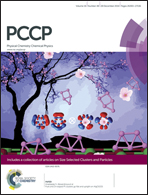Anomalous modulation of photoinduced electron transfer of coumarin 102 in aniline–dimethylaniline mixture: dominant role of hydrogen bonding†
Abstract
In a previous study, we reported a striking observation that photoinduced electron transfer (PET) from aniline (AN) to photoexcited coumarin 102 (C102) can be accelerated by adding an inert component (cyclohexane or toluene) to the neat electron donor solvent AN (Phys. Chem. Chem. Phys., 2014, 16, 6159–6166). The H-bond linking the electron donor (D, AN) and the acceptor (A, C102) was proposed to dictate the PET process. To account for the unusual variation of quenching pattern with AN mole fraction, two possible reasons were cited – (1) the D–A (AN–C102) H-bonding may be modulated due to change in polarity of the medium or (2) the additional D–D (AN–AN) H-bonding may restrain the D–A H-bonding to adjust optimally for the PET. Here, we investigate the PET of C102 in an AN–dimethylaniline (DMA) mixture to negate the polarity variation. Since, both AN and DMA have similar polarities, the polarity of the mixture should remain invariant at all compositions. Nevertheless, we found that the fluorescence quantum yield and lifetime of C102 in the mixtures follows a similar unusual trend as observed earlier in the AN–toluene or AN–cyclohexane mixtures; it first decreases up to a particular mole fraction (XD) of the H-bond donor AN and, thereafter, increases on further enrichment of the donor. The observed PET modulation may be rationalized by considering efficient PET in the 1 : 1 H-bonded C102–AN complex but less efficient PET in higher order C102–(AN)n≥2 complexes, where additional D–D (AN–AN) H-bonding may influence the key C102–AN H-bonding and thus inhibit the PET process.


 Please wait while we load your content...
Please wait while we load your content...